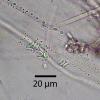
15-12-2025 07:09
 Danny Newman
Danny Newman
indet. Rutstroemiaceae sp. on unk. fallen leavesMc

18-12-2025 21:17
Pol DebaenstThe identification took me to Byssonectria deformi

19-12-2025 10:10
Patrice TANCHAUDBonjour, récolte réalisée en milieu dunaire, a

18-12-2025 17:23
 Bruno Coué
Bruno Coué
Bonjour,je serais heureux d'avoir votre avis sur c

18-12-2025 18:07
Margot en Geert VullingsThese plumes were found on rotten wood.They strong

17-12-2025 18:35
 Michel Hairaud
Michel Hairaud
Bonjour à tous/Hi to everyone I am passing along

15-12-2025 15:48
 Danny Newman
Danny Newman
Melanospora cf. lagenaria on old, rotting, fallen

15-12-2025 15:54
 Johan Boonefaes
Johan Boonefaes
Unknown anamorph found on the ground in coastal sa

15-12-2025 21:11
 Hardware Tony
Hardware Tony
Small clavate hairs, negative croziers and IKI bb
asco with spore-clusters
Ida Bruggeman,
29-01-2014 13:08
Walter Gams,
29-01-2014 14:09
Re : asco with spores clusters on twig
Probably a Dipodascus species.
Ida Bruggeman,
29-01-2014 17:34
Re : asco with spores clusters on twig
I forgot to mention that I have even wondered whether perhaps this is no ascomycete, greeting, Ida
Sorry I did not see that there is a reply.Thanks I am going to investigate this,
Ida
Sorry I did not see that there is a reply.Thanks I am going to investigate this,
Ida
Ida Bruggeman,
29-01-2014 21:23
Re : asco with spore-clusters
I went through the descriptions of the species of this genus in Mycobank. It seems that my specimen is close to D. armillaria, australiensis and D. geniculatus, but differs from these and all other species (of which descriptions were available) in the large asci: 44-80 x 16-24 um and the larger spores: 8-10.5 x 3,5 -6 um.
From the description I learned that those things that I had considered a imperfect parasite are indeed the anamorf, and that my specimens produces plenty of arthrospores and a few chlamydospores.
All description on Mycobank are from cultures and I wonder whether the size of asci and spores can be different in cultures from in nature. Does anyone know?
Ida
From the description I learned that those things that I had considered a imperfect parasite are indeed the anamorf, and that my specimens produces plenty of arthrospores and a few chlamydospores.
All description on Mycobank are from cultures and I wonder whether the size of asci and spores can be different in cultures from in nature. Does anyone know?
Ida
Walter Gams,
30-01-2014 11:50
Re : asco with spore-clusters
The size of the asci is iindeed quite variable. An accurate identification will not be possiible wiithout a pure culture. You will find the necessary information in Studies in Mycology vol. 29 and vol. 50: 489-515, 2004. Freely available for download.
Ida Bruggeman,
30-01-2014 22:46
Re : asco with spore-clusters
Thanks a lot for the literature. As far as I can see it could be either D. aggregatus or D. australiensis.
It differs, however, from both in the much larger number of spores 100 (estimated) versus 20-30/ ascus, the wider asci (16-24 µm versus 6-11) and the narrower spores (Q 2.0-2.8 versus ca. 1.2-1.3 and ca. 1.5-1.6).
It differs, however, from both in the much larger number of spores 100 (estimated) versus 20-30/ ascus, the wider asci (16-24 µm versus 6-11) and the narrower spores (Q 2.0-2.8 versus ca. 1.2-1.3 and ca. 1.5-1.6).







 spores more
spores more